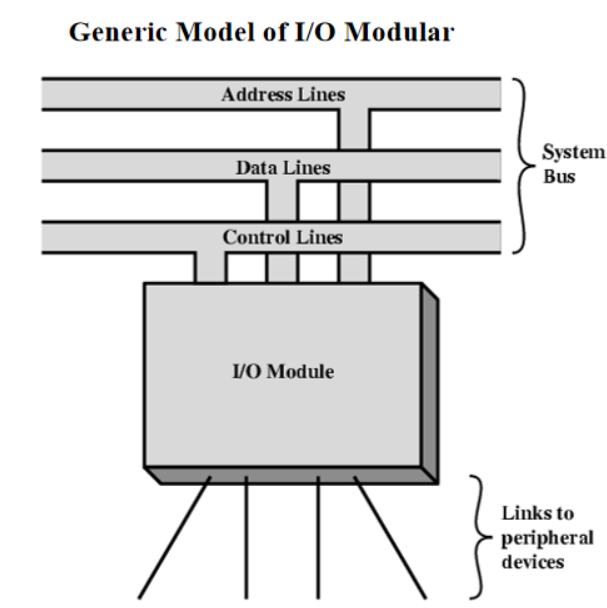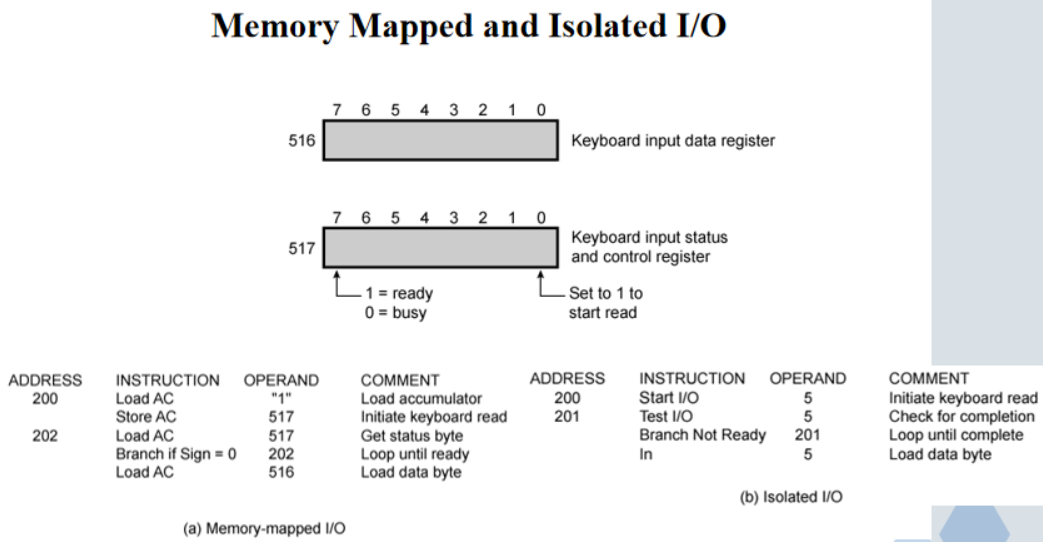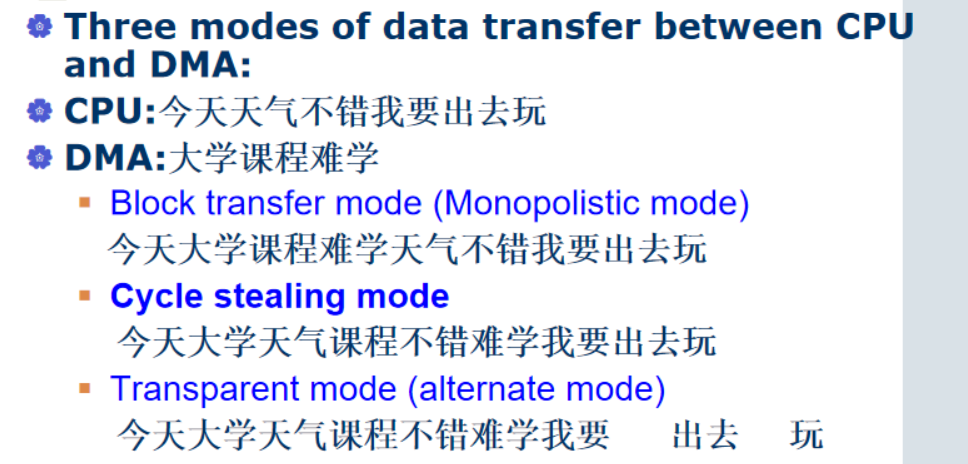本文内容整理自西安交通大学软件学院李晨老师的课件,仅供学习使用,请勿转载
计算机组成原理系列笔记汇总:计算机组成原理笔记及思维导图汇总附复习建议_Qlz的博客-CSDN博客
文章目录
文章目录
- 文章目录
- 本章思维导图
- External Devices
- I/O Modules
- Programmed I/O
- Interrupt Driven I/O
- Direct Memory Access
- I/O Channels
- External Interface
- Key points
- Vocabulary
本章思维导图
External Devices
I/O Speed: bytes transferred per second(from mouse to display: 10-to-million)


Disk drive
- Contain two types of electronics
- One type for exchanging data, control and status signals with an I/O module
- The other for controlling the disk read/write mechanism
I/O Modules
Function of I/O Module
- Control & Timing
- CPU ~ I/O Communication
- Device ~I/O Communication
- Memory ~ I/O communication
- Data Buffering
- Error Detection
I/O Steps
- CPU checks I/O module and device status
- I/O module returns status
- If ready, CPU requests data transfer
- I/O module gets data from device
- I/O module transfers data to CPU
- Programmed-I/O
- Interrupt-Driven I/O
- DMA/Channel
I/O Communication
- Command decoding:
- Read sector, Seek track, Scan ID
- Which blocks can be read or written.
- Data exchange
- External data I/O module buffer through local bus
- I/O module buffer CPU/memory through system bus
- Status reporting
- Busy, ready, error, etc
- Address recognition
- Recognize each peripheral
Data Buffering
- Adapt peripherals to CPU or main memory in their velocities
- CPU/DRAM ← → \leftarrow \rightarrow ←→ I/O buffer
- I/O buffer ← → \leftarrow \rightarrow ←→ peripherals
Error Detection
- An I/O modular is often responsible for error detection and reporting errors to CPU
- One class of errors is hardware failure
- Mechanical or electrical
- E.g.: paper jam, bad disk track
- Another class of errors is transmitting errors
- Bit errors
- Data losses

I/O Module Decisions
- Support multiple or single device
- Hide or reveal device properties to CPU
- Control device functions or leave for CPU
- Also O/S decisions
- e.g. Unix treats everything it can as a file
Input Output Modes
- Programmed
- Interrupt driven
- Direct Memory Access (DMA)
- I/O Channel
- I/O processor
Programmed I/O
-
With programmed I/O, data are exchanged between the CPU and I/O modular
-
CPU has direct control over I/O in a program
- Sensing status
- Read/write commands
- Transferring data
-
CPU waits for I/O module to complete operation when it issues an I/O command
-
Wastes CPU time
process
- CPU encounters an I/O instruction
- CPU executes it, by sending a command to I/O modular, and waits for the I/O modular ready
- I/O modular performs the command and then set the appropriate bit in the I/O status register
- CPU periodically checks the status bit until it find the operation completed
I/O Commands
- CPU issues address
- Identifies module & device ( if >1 per module)
- CPU issues commands: 4 commands
- Control - telling module what to do
- e.g. rewind, open disk drive, etc
- Test - check status
- e.g. power? Error?
- Read/Write
- Module transfers data via buffer from/to device
- Control - telling module what to do
Addressing I/O Devices
- Under programmed I/O data transfer is very like memory access (CPU viewpoint)
- Each device given unique identifier
- CPU commands contain identifier (address)
I/O Mapping
不太明白
- Memory mapped I/O
- Devices and memory share an address space
- 0xxxxxx, 1xxxxxx
- I/O looks just like memory read/write
- No special commands for I/O
- Large selection of devices available
- Devices and memory share an address space
- Isolated I/O
- Separate address spaces
- Need I/O or memory select lines
- Special commands for I/O
- Limited set

Summary
- Advantage:
- Simple: processor is totally in control and does all
- Disadvantage:
- Polling overhead can consume a lot of CPU time
- Solution: use exception mechanism to help I/O. Interrupt program when I/O ready, return when done with data transfer
Interrupt Driven I/O
- Overcomes CPU waiting
- No repeated CPU checking of device
- I/O module interrupts when ready
Interrupt Driven I/O Basic Operation
- CPU issues read command, and then do other things
- I/O module gets data from peripheral whilst CPU does other work
- I/O module interrupts CPU
- CPU requests data
- I/O module transfers data through bus
- At last, CPU recover previous work
CPU Viewpoint
- Issue read command
- Do other work
- Check for interrupt at end of each instruction cycle
- If interrupted:-
- Save context (registers)
- Process interrupt
- Fetch data & store
- Restore context
- Continue previous work
I/O Module Viewpoint
- Receive a READ command from CPU
- Detect the state of the peripheral
- Read data from the peripheral, put it into registers
- Signal an interrupt to CPU
- Wait until its data are requested by CPU
- Place the data on the data bus

Design Issues
How do you identify the module issuing the interrupt
- Multiple interrupt lines
- Different line for each module, Limits number of devices
- Software poll
- CPU asks each module in turn through interrupt-service subroutine
- Command + address of I/O module
- Read addressable status register contained in each I/O module
- CPU branches to the device service routine
- Slow (time consuming)
- CPU asks each module in turn through interrupt-service subroutine
- Daisy chain or Hardware poll Bus
- All I/O modules share a common interrupt request line
- Once CPU senses an interrupt, Interrupt Acknowledge sent down a chain
- Module responsible places vector (address, id) on bus
- CPU uses vector to point to an appropriate device-service routine
- Referred to as vectored interrupt
- Arbitration (vectored)
- Module must claim the bus before it can raise interrupt
- CPU detects the interrupt, respond it through interrupt acknowledge line.
- I/O module places vector on the data bus
- e.g. PCI & SCSI
How do you deal with multiple interrupts
- With multiple lines, Each interrupt line has a priority
- Higher priority lines can interrupt lower priority lines
- With software polling, the order in which modules are polled determines their priority
- With daisy, the order of modules on the daisy determines their priority
Direct Memory Access
Drawbacks of programmed and interrupt-driven I/O
- Programmed I/O needs to occupy all CPU time
- Interrupt driven I/O still requires active CPU intervention, though more efficient CPU usage than Programmed I/O (transfer rate is lower)
- In both modes, data transfer must traverse CPU
- Transfer rate is limited
- CPU is tied up
- When large volumes of data are transferred, DMA is a more efficient technique
What is DMA
- External to the CPU
- Additional Module (hardware) on bus
- DMA controller takes over from CPU for I/O
- Transfer blocks of data to or from memory without CPU intervention
- In fact, DMA is also an I/O module
- Act as a master on the bus
- Memory system acts like slave
- Manage byte-word conversion
- Priority: DMA > CPU
Three modes of data transfer between CPU and DMA
- Block transfer mode (Monopolistic mode)
- 当DMA传送数据的时候,CPU不能使用总线
- An entire block of data is transferred in one contiguous sequence
- If DMA transfers data, CPU be disabled for a duration until DMA release bus
- Useful for loading an programs or data files into memory
- Cycle stealing mode
- DMA与CPU交替传输数据
- DMA uses the bus only when CPU does not need it or forcing CPU to suspend operation temporarily
- DMA transfer one word of data, then release bus
- DMA interleaves instructions and data transfers
- Transparent mode (alternate mode)
- DMA与CPU分别占用时钟的上升沿和下降沿工作
- DMA and CPU use bus by division time multiplexing
- Require most time, but most efficient

DMA Structure
数据总线分别于数据计数器,数据寄存器,地址寄存器相连
过程
CPU首先通过Address Lines向地址寄存器发送需要请求的设备地址号,DMA将CPU传来的设备号直接发给I/O,然后CPU通过Data Lines向DMA发送对应的内存地址,存入地址寄存器中保存,CPU通过数据线将数据发送至数据寄存器,DMA将该数据再写入I/O设备中
- Preprocessing: CPU tells DMA controller
- Read/Write
- Device address
- Starting address of memory block for data
- Amount of data to be transferred
- CPU carries on with other work
- Data transferring: DMA controller deals with transfer (word by word)
- Postprocessing: DMA controller sends interrupt when finished

DMA Transfer Cycle Stealing
- DMA controller takes over bus for a cycle
- Transfer of one word of data
- Not an interrupt
- CPU does not switch context
- CPU suspended just before it accesses bus
- i.e. before an operand or data fetch or a data write
- Slows down CPU but not as much as CPU doing transfer
DMA and Interrupt Breakpoints During an Instruction Cycle

DMA Configurations
Single Bus, detached DMA controller
- Each transfer uses bus twice
- I/O to DMA then DMA to memory
- CPU is suspended twice

Single Bus, Integrated DMA controller
- Controller may support >1 device
- Each transfer uses bus once
- DMA to memory
- CPU is suspended once

Separate I/O Bus
- Bus supports all DMA enabled devices
- Each transfer uses bus once
- DMA to memory
- CPU is suspended once

例题

I/O Channels
- I/O channel is an I/O module with its own processor which can execute I/O program
- I/O program is located in main memory
- In fact, the I/O channel represents an extension of the DMA concept
- Thus, an I/O channel has the ability to execute I/O instructions and control the I/O operations
Functions of I/O Channels
- Receive command from CPU
- Micro command
- Load I/O program from memory, send commands to device
- Buffer, control and transfer data, provide path for transferring
- Report device status or interrupt
Working Principle
- Master CPU sends I/O command and waits channel and device ready
- the number of Channel
- the number of device
- Entry of channel program
- Size of data
- Master CPU starts the channel and returns to main program
- The channel executes I/O program to transfer data between memory and device
- When data transfer completed, interrupt CPU
Types of I/O Channels
Channel Capacity/data-transmission rate
- Maximum data transmitted per unit time of channel
Selector channel
- At any one time, only one device is selected to transfer data
- High-speed devices

Multiplexor channel
- Byte multiplexor channel
- Round robin between devices
- For a device, only one byte data transferred
- For low speed devices
- Block multiplexor channel
- Round robin between devices
- For a device, K bytes data transferred

Evolution of the I/O Function
- CPU directly control a peripheral
- A control or I/O module is added
- programmed I/O
- Interrupt-driven I/O
- DMA
- Device–memory
- I/O channel
- I/O processor, no local memory
- I/O processor
- I/O processor + local memory
External Interface
没讲
Connecting devices together
- Point to point
- Dedicated line between I/O module and external devices
- E.g. keyboard, printer, modem, etc.
- Point to multi-point
- external buses
- External mass storage
- Multimedia devices (CD-ROMs, video, audio)
Serial or parallel
- Printer, mouse, keyboard, etc.
- Disk, tape, etc.
Write operation from I/O module to a peripheral
- I/O module sends a control signal requesting permission to send data
- The peripheral acknowledges the request
- The I/O module transfers data
- The peripheral acknowledges the receipt of the data
Small Computer Systems Interface (SCSI)
- Standard interface for CD-ROM drive, audio equipment, external mass storage devices
- Parallel interface
- 8, 16, 32 bit data lines
- Daisy chained local bus, attached to PCI
- Devices are independent
- Devices can communicate with each other as well as host
Key points
- Functions of I/O Module?
- I/O module structure
- Input Output Modes
- What is 82c59a?
- DMA &channel
- SCSI
- Firewire
Vocabulary
- Cycle stealing: 周期窃取
- Interrupt: 中断
- Isolated I/O:分离式I/O
- Memory-mapped I/O:存储映射式I/O
- Multiplexor channel:多路转换通道
- Parallel I/O:并行器I/O
- Peripheral device : 外围设备
- Selector channel:选择通道























 163
163











 被折叠的 条评论
为什么被折叠?
被折叠的 条评论
为什么被折叠?










